Fleshy and very tasty tomato “Mishka clubfoot”: reviews and agrotechnical techniques for increasing yield
Every gardener wants to grow large and tasty tomatoes in his garden. The Mishka clubfoot variety is perfect for this. This tomato has established itself as a crop that is grown in almost all regions of Russia.
The vegetable contains many useful substances, and its agricultural technology is almost no different from other tomato varieties. However, there are still some nuances and subtleties - you will learn about them from our article.
Description of the variety
The Mishka clubfoot variety belongs to the indeterminate type of plants, that is, the crop is not limited in growth. The leaves are dark green and medium in size. Tomatoes of this variety are successfully grown both in greenhouse conditions and in open ground. The culture needs garter and stepsoning.
Varieties of tomatoes Teddy bear
The variety has several varieties:
- Yellow. A vegetable with a pleasant, richly sweet taste. The bush reaches a height of 2 m. The culture has strong immunity to fusarium, alternaria and tobacco mosaic virus. Vegetable growers speak positively about tomatoes.
- Red. This variety is the most famous. Tomato stems reach a height of 2 m. The crop is mainly grown in greenhouse conditions. The fruits and pulp have a rich crimson color. The vegetables taste sweet and tender. Summer residents collect 5-6 kg from one bush. The plant has strong immunity to characteristic tomato diseases.
- Orange. Bright tomatoes decorate beds well.The fruits are fleshy, aromatic, sweet and juicy. The use of vegetables is universal - they are used in fresh salads and for preservation. The plant grows strongly and requires pinching. It is formed into two stems. The culture is resistant to most diseases.
- Pink. When the fruits of this variety hang on the bushes, they look like large pink drops. Each reaches 800-900 g. Up to 6 kg of crop is harvested from one plant. The mid-season variety needs pinching.
Reference. Multi-colored vegetables taste virtually the same.
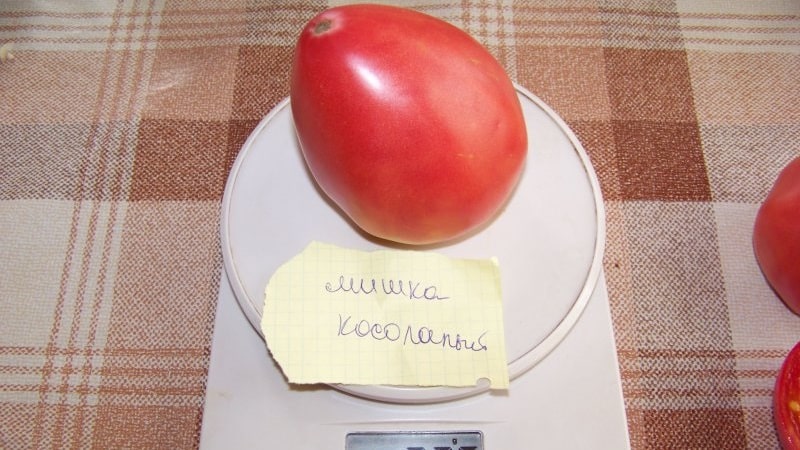
Distinctive features
The variety produces a bountiful harvest in open and closed ground and has strong immunity to most diseases. Elastic fruits tolerate transportation well and are stored for a long time. If the vegetable is picked green, it will ripen perfectly on its own on the windowsill or in the pantry.
Fruit characteristics and yield
The clusters bear 5 fruits. The weight of one tomato is 700-800 g, but with good care it can reach 900 g. Tomatoes have a heart-shaped round shape, thin skin and juicy pulp. There are few seeds in tomatoes. The vegetables taste sweet, without a sour aftertaste. The largest fruits grow on the first clusters, slightly smaller on subsequent clusters. From 4 to 6 kg of crop is harvested from one bush.
How to grow seedlings
The Mishka clubfoot variety is grown in seedlings. The seeds for this are sown in the last ten days of March. The soil can be purchased from a specialized store or prepared independently.
Seed preparation
The seed package will indicate whether the grains have been pre-treated by the manufacturer. In any case, the material is rejected. The grains are placed in a 3% saline solution (30 g of salt is stirred in 1 liter of water) for 20-30 minutes.
Seeds that fall to the bottom of the container are selected for planting, and those that float are thrown away. Then the grains are washed under running water and disinfected in a 1% solution of potassium permanganate.
The washed seeds are germinated. To do this, they are laid out on damp cotton cloth or cotton pads and placed in a container that is sealed using plastic bags. The grains are periodically moistened.
Important! The seed material is only moistened. The grains should not float.
Germination at room temperature +25 °C takes 3-4 days. When the length of the sprout matches the size of the grain, it means the seeds are ready for sowing.
Container and soil
To grow seedlings, use wooden or plastic boxes, cut bottles or milk cartons, cups or peat tablets. The latter option is most preferable, since such containers contain a nutritious soil mixture.
When picking, the peat cup along with the seedlings is moved into a large container. After some time, the walls of the container become limp and dissolve in the soil. At the same time, the root system remains intact, and the plant itself does not experience stress when conditions change.
The following components are mixed for the soil:
- manure – 1 part;
- river sand – 1 part;
- neutral peat – 1 part;
- garden soil - 3 parts.
Important! 1-2 days before sowing, the finished soil is disinfected with a strong solution of potassium permanganate. After the procedure, beneficial bacteria begin to develop in the soil for crop growth.
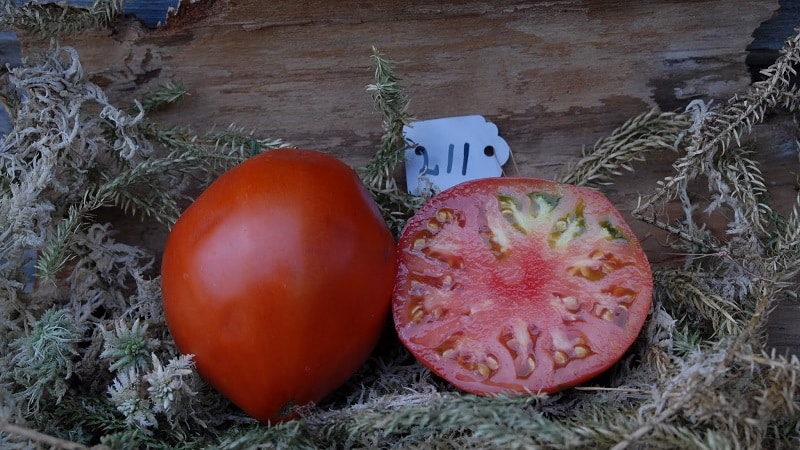
Sowing
Tomato seeds are planted 1-2 cm into the soil and lightly sprayed so as not to erode the soil. Next, the container with grains is covered with polyethylene and placed in a heated place until germination.When the first shoots appear, the shelter is removed and the seedlings are placed in a bright place, for example, on a windowsill.
Growing and care
To keep young plants strong and healthy, they are watered in a timely manner and provided with sufficient light. The seedlings are kept indoors at a temperature of +25 °C. When the young plants have 2 true leaves, they are planted into separate containers.
For good seedling development, do the following:
- When transplanting, the sprouts are deepened almost to the cotyledon leaves.
- Plant roots are disinfected in a weak solution of potassium permanganate.
- 10-14 days after picking, the tomatoes are fed for the first time. Further fertilizing is applied every 10-14 days. Mullein infusion is used as a fertilizer.
- Tomato seedlings are hardened. Two weeks before the intended planting, the plants are taken out onto the street or balcony for 1-2 hours. The time the seedlings spend in the fresh air is gradually increased.
How to grow tomatoes
Proper cultivation of the Mishka clubfoot variety consists of timely moistening and loosening the soil and periodically weeding the beds to remove weeds. Although the crop has good immunity to diseases, vegetable growers treat the soil with a weak solution of potassium permanganate for prevention.
Landing
When young plants have 6-7 true leaves, they are transplanted to a permanent place of growth. This is usually done at the end of April - beginning of May. Tomatoes are planted under cover according to a 30x50 cm pattern. As each plant grows, it is carefully tied to a support.
Tomatoes are transplanted into open ground in early June. Since the plants are tall, leave 50 cm between rows and 40 cm between bushes.
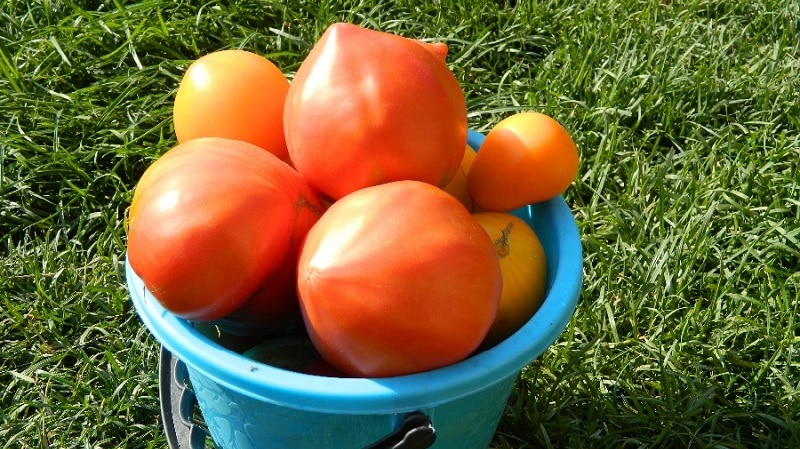
Care
Tomatoes watered regularly and abundantly, without allowing the soil to dry out. But excessive moisture also has a bad effect on plants. The procedure is performed in the morning or evening hours, when the sun is not shining. Use settled water at room temperature. Water the bushes at the roots.
To form large and fleshy vegetables, the crop is fertilized once every 14 days throughout the growing season. Organic and mineral fertilizers are alternated as fertilizing. They try not to use manure, as it promotes the growth of green mass and weeds, which slows down the development of fruits.
The variety is formed into 1-2 stems. All stepsons that are located above the second hand are removed. Shoots longer than 5 cm are cut off. For better development of the stem, pinch the top of the plant and remove deformed flowers.
When white tubercles appear on the stem at the base, the bushes spud. This means that due to a lack of nutrients, the plant intends to strengthen the root system.
The variety belongs to indeterminate, its shoots are long and weak. Therefore, the crop cannot withstand the load of heavy fruits without support. Tall variety tie up to a trellis or peg.
Did you know? Tomatoes contain a large amount of serotonin (the hormone of happiness), so this wonderful vegetable can lift your spirits just as well as chocolate. The bright color of the fruit also helps with this.
Possible difficulties during cultivation
To obtain a bountiful harvest, the crop is provided with timely watering and regular fertilizers.
Diseases and pests
The tomato variety Mishka clubfoot shows good resistance to the following diseases:
- late blight;
- fusarium;
- tobacco mosaic.
There is a small risk of the crop being affected by white or gray rot. Apical or root rot also occurs. Often, ripe vegetables begin to rot, especially if the tomatoes are orange or bright red.
Preventive measures help protect plants from diseases and pests. First of all, for prevention, weeds and lower rows of leaves are removed, then the soil is loosened and mulched. If tomatoes are grown in a greenhouse, it must be ventilated, and on sunny days it is left open for the day.
Pests are also common. Get rid of slugs with an aqueous solution based on ammonia, and if the tomatoes are attacked by flying insects, use insecticidal agents.
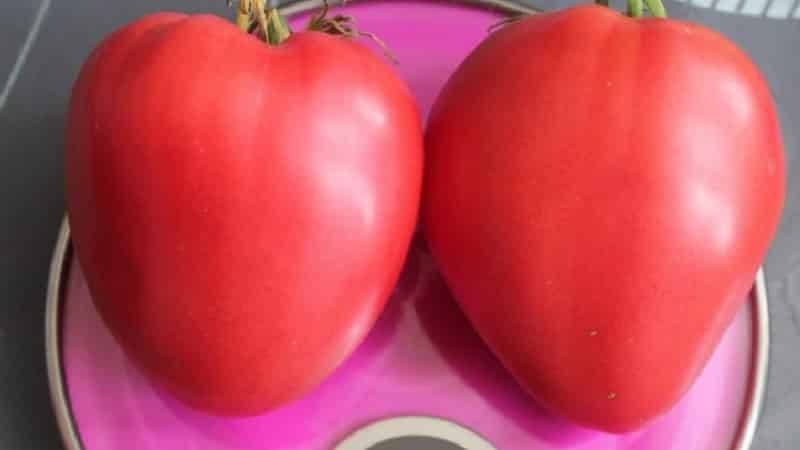
The nuances of cultivating tomatoes
The main feature of growing this variety is the need for mulching soil. To do this, use sawdust, straw, compost or humus. Mulch prevents the growth of weeds and cracking of the earth, retains moisture longer and keeps cool well on hot days.
Harvesting and application
Tomatoes are harvested as they ripen. Over-ripening of fruits is not allowed, so as not to provoke the development of rot. The Mishka clubfoot variety ripens well on its own, so the fruits are often picked green and then laid out on the windowsill to ripen. To do this, maintain a temperature of at least +20 °C.
Summer residents use fresh tomatoes when the vegetables contain the maximum amount of beneficial properties.
Tomatoes are used to make sauce, paste and juice. Tomatoes are pickled. The fruits are not used for preservation due to their large size.
Advantages and disadvantages
Positive properties of the variety:
- excellent taste;
- high content of nutrients;
- ease of care;
- disease resistance;
- high productivity;
- good transportability.
The variety has practically no disadvantages, except for its demands on fertilizing and pinching. Against the background of positive characteristics, minor shortcomings are invisible, which is why many vegetable growers prefer this particular tomato.
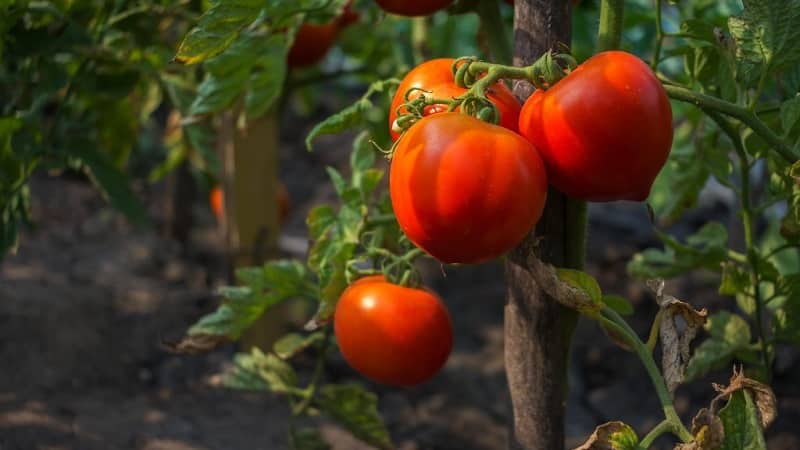
Review Reviews
Summer residents speak mostly positively about the Mishka clubfoot variety. Many gardeners are pleased that even if the fruits did not have time to ripen before the onset of frost, they can be picked green - they will ripen successfully even without a bush. This characteristic allows even residents of the northern regions to enjoy a bright and tasty vegetable. Reviews from summer residents - further.
Alexey, Tomsk: “That year, I grew the tomato variety Mishka clubfoot on my plot. I purchased seedlings ready-made at the market. Since I don’t have a greenhouse, I transplanted the plants into open ground. Over the entire summer I applied 3-4 additional feedings. I used superphosphate and humus for this. The bushes grew tall and there were a lot of ovaries. Some fruits were collected green and then stored in the pantry. After a week, the tomatoes ripened and became sweet.”
Vera, Ulan-Ude: “In my city the climate is unpredictable. For many years now, I have always been trying to grow new varieties of tomatoes in the greenhouse. A neighbor advised me to plant a tomato called Mishka clubfoot. I cultivated several varieties of this vegetable. The fruits have grown large and beautiful, as in the photo of the package with seeds. The culture, of course, requires a little attention, but always pleases with an abundant and high-quality harvest. In general, I liked the tomato variety Mishka clubfoot.”
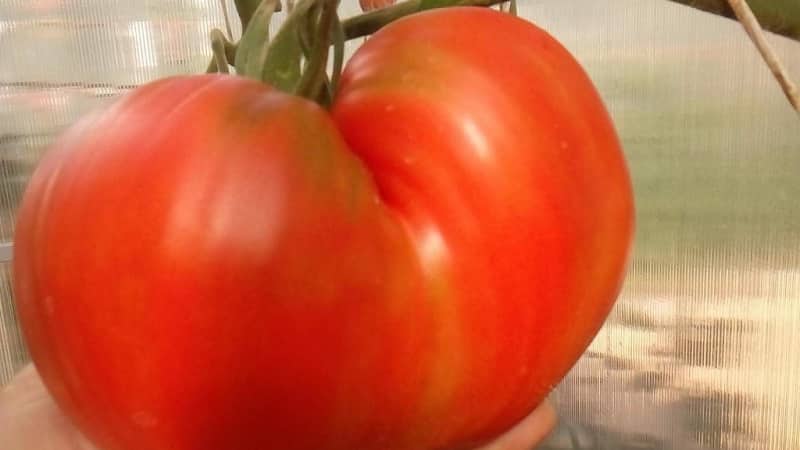
Conclusion
The tomato variety Mishka clubfoot pleases with large and high-quality vegetables.The culture is unpretentious in care and can grow both in open ground and in greenhouse conditions. In addition, the plant is resistant to most diseases, which greatly simplifies the cultivation of this vegetable.
You will learn more about the Mishka clubfoot tomato from the following video: